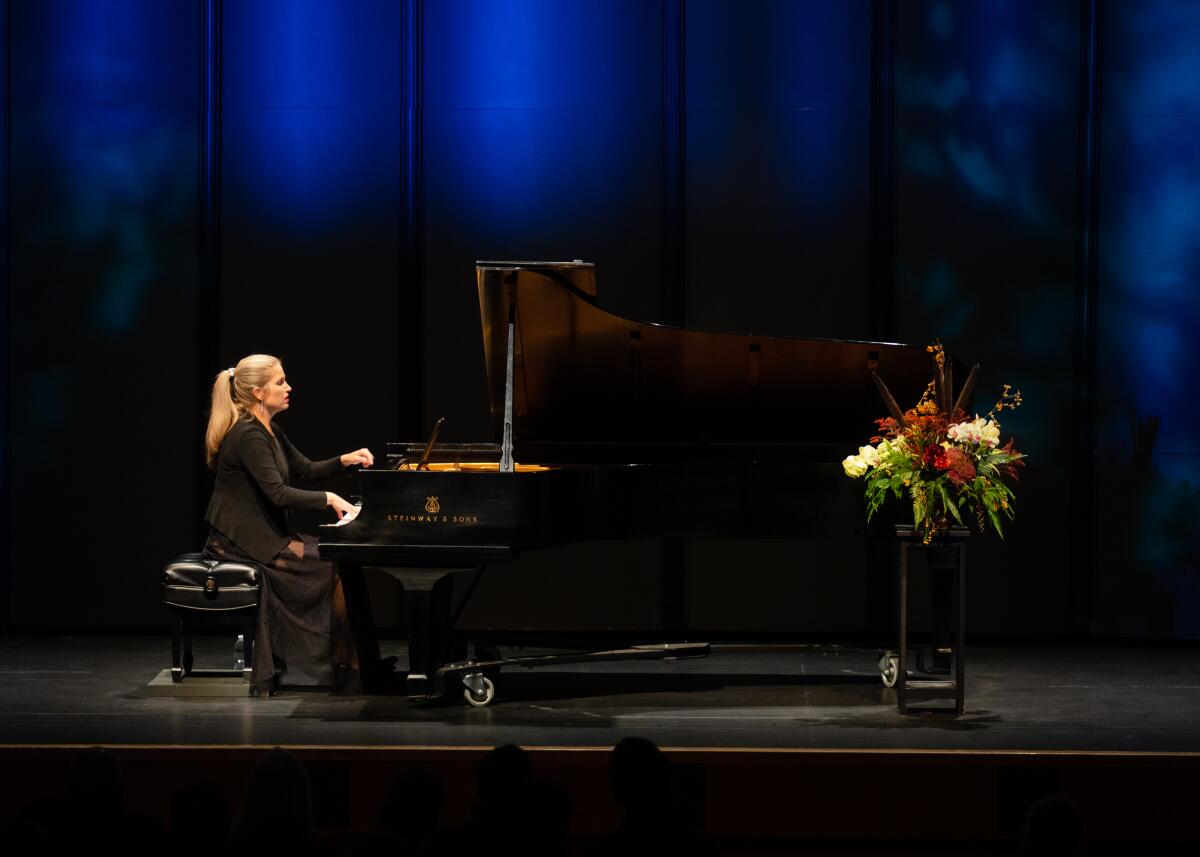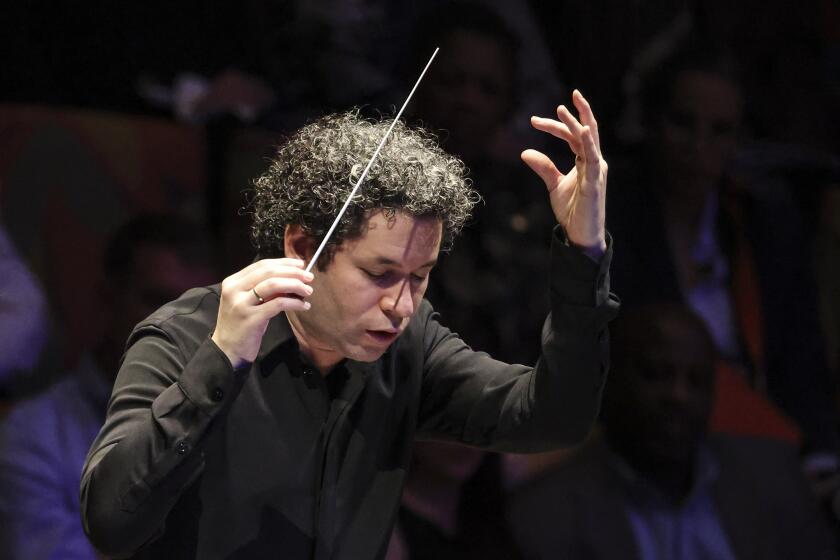Review: What is Pan-American music? Gustavo Dudamel and pianist Gabriela Martinez have some ideas

Pete Seeger’s legendary “We Shall Overcome” concert at Carnegie Hall in 1963, the event that signaled the indispensable way music could inspire ’60s-era political reform, ended on an exceptionally high point. The eloquent, indeed definitive, performance of the patriotic Cuban song “Guantanamera” made every syllable in José Martí’s poems consequential. Seeger, however, introduced the song by saying “people” had put one of Martí’s last poems to a popular tune. It wasn’t “people,” it was Julián Orbón.
Orbón is duly credited on the jacket of the concert’s live recording. Maybe Seeger had a mind slip. Maybe he had a problem with Orbón. Maybe there is just an Orbón problem, which could explain why Julián Orbón de Soto, who was born in the Asturias region of Spain in 1925, moved with his family to Havana in 1938 and rose to be considered by many to be the country’s most promising young composer, has been unjustly neglected.
That injustice was addressed by the Los Angeles Philharmonic at Walt Disney Concert Hall Thursday night, the first concert in Gustavo Dudamel’s new Pan-American Music Initiative. The program ended with a stirring performance of Orbón’s “Tres Versiones Sinfónicas.” Orbón was just 28 when he wrote the score and gave it its unfortunately uninspiring title describing it as merely three varied symphonic pieces.
Even in the Pan-American Initiative — which is not a festival but a broad, ongoing effort at inclusivity — Orbón seemed an afterthought. The evening, which began the L.A. Phil’s fall season, was to have been devoted exclusively to Venezuelan, Mexican and Brazilian composers. Yet in a late change of direction, Dudamel instead led John Adams’ “I Still Dance,” Mozart’s Flute and Harp Concerto as well as his “Serenata Notturna” and the Orbón.
Yuja Wang, John Williams, Michael Tilson Thomas and Chaka Khan will make appearances, with additional programming to be announced throughout the year.
As luck would have it, Saturday night at the Eli and Edythe Broad Stage, the Venezuelan pianist Gabriela Martinez played an intriguingly original Pan-American program that combined works by Venezuelan and Brazilian composers with recent ones from the U.S.
Dudamel and Martinez raise the question of what it means to be Pan-American. Virgil Thomson defined American music as music written by an American.
Is Reynaldo Hahn’s “Portraits de Peintres,” which Martinez played, Venezuelan? The composer was born in Caracas and emigrated to Paris in his youth. These piano miniatures are musical impressions of four early poems by Proust about painters (for a brief time, Hahn and Proust were lovers). On the surface, they sound as French as Ravel, who was a classmate of Hahn’s. But they don’t sound like Ravel. It is hard to say whether there is a hint of Venezuelan influence in Hahn’s effervescent melodies and vibrating accompaniments, or whether it just seems that way knowing Hahn’s origins.
“Tres Versiones” offers a fascinating rabbit hole of musical influences and identities in which to get lost. The first movement, “Pavana,” begins with melody by the Spanish Renaissance composer Luis de Milán magisterially belted out by French horns and accented off the beat in its last notes, ending on a punctuated Coplandesque chord by piano and harp. The year was 1953, the year of Castro’s “History Will Absolve Me” speech.
The Orbóns had fled Spanish Civil War, and Julián became an eager initial supporter of the Cuban Revolution. The Milán tune is gradually given the full Copland treatment, almost becoming a fanfare for the common Cuban.
The most astonishing movement, the second, is titled “Organum-Conductus.” It begins, mystically, with a chant melody by the radical 12th century composer Pérotin, who would become a seminal influence on Steve Reich and the development of American Minimalism a dozen years later. In Orbón’s hands, Pérotin takes on symphonic rapture, growing ever more euphoric and more boldly colored. The last movement, “Xylophone,” is an Afro-Cuban dance made exceptional by a large contingent of percussion.
Having grown disillusioned by the Cuban Revolution, Orbón left in 1960 for Mexico City. He moved to New York the year of Seeger’s Carnegie concert and taught at Columbia University until his death in 1991. In New York, he was thought of as a Spanish Neoclassicist. Dudamel made it thrillingly evident that Orbón needs to be reconsidered as something like a pan-Spanish-Cuban-American and neo-Medieval-Renaissance Modernist.
Mozart’s Concerto for Flute and Harp might on first blush seem an appropriate Neoclassical Pan-American fit, since flute and harp are popular instruments in Latin, folk, pop, jazz and classical musics. Except Mozart hated both instruments. That however, didn’t stop principal flutist Denis Bouriakov and principal harpist Emmanuel Ceysson from delivering a vibrant performance. Plus, Ceysson’s Art Deco red harp looks like it would have nicely fit in at a 1950s Havana nightclub.
Adams’ “I Still Dance” was written in 2018 to celebrate Michael Tilson Thomas and his husband, Joshua Robison. A curtain-raiser, it helped launch MTT’s last season as the transformative music director of the San Francisco Symphony. The influences are not Latin (although there is plenty of that in Adams’ beloved oratorio, “El Niño”), but is more in the spirit of Duke Ellington, with African and Japanese percussion, along with an electric bass guitar, thrown into a blazing orchestral mix that doesn’t stop for close to eight minutes.
Tilson Thomas conducted it as a kind of fantasy, a luminous vision of the ballroom. Everything goes by very fast. The rhythms are mind-bending. It takes virtuoso hearing just to follow the score. But for Dudamel, this was no fantasy. “I Still Dance” became “I Dance.”
The original L.A. Phil program would have ended with a Villa-Lobos’ Chôros No. 10. Instead, Tilson Thomas, who remarkably still conducts despite grappling with brain cancer, will conduct it with the L.A. Phil in January. But Martinez filled the void for now by ending her Broad program with Villa-Lobos’ “Bachianas Brasileiras” No. 4 in its original piano version.
She is a remarkable pianist who has had a good deal of exposure but remains for some mysterious reason on the sideline. Saturday was a return to the Broad. She’s performed at the Soraya and as soloist with the Pasadena Symphony and the Pacific Symphony. She’s not hard to find on YouTube. But despite having been a soloist for Dudamel in Venezuela, she has yet to appear with the L.A. Phil or in Disney Hall.
Based in New York, Martinez is attuned to its new music scene, and she included short pieces by Missy Mazzoli (“Heartbreaker”), Caroline Shaw (“Gustave Le Gray”) and Sarah Kirkland Snider (“The Currents”). All three women are very much in demand and very much played. But they couldn’t have a better champion.
With a cool determination, a tone full of glowing color and a seemingly effortless technique, Martinez got Mazzoli’s miniature to glow darkly. A Chopin mazurka floated on air out of shimmering chords in Shaw’s score, while Snider’s quiet tolling of bells was so majestic that it almost seemed like electronic music. Melody in all three of these pieces needs to be assembled a note at a time. Martinez did so by providing such substance to each individual note that she gave the impression of capturing it from the air, like a flying insect, and attaching it the piano so that it could join the next one.
The stunner was “Veil” by Viet Cuong, a Vietnamese American composer from L.A. who is receiving considerable attention of late (the Pacific Symphony just opened its new season with his percussion concerto, “Re(new)al”). “Veil” is about just one note, a G sharp that tolls throughout and keeps changing based on how it is hit, how the strings are damped (Martinez played inside the piano and out) and the harmonic context it is put in.
“Veil” wasn’t written for Martinez, but it sounded like it must have been, on some level. Her touch is magical. She lifts the veil and reveals, in G sharp, a world in sound, pure to the point of having no nationalities and all nationalities. It opened the ears to all.
A magnificent performance of Villa-Lobos’ seductive “Bachianas Brasileiras” followed. This 20th century Brazilian channeling of Bach flowed naturally from Cuong’s G sharps, leaving that impression that, while the scenery differs, the Amazon, Rhine and Mekong are all rivers, and water everywhere is nourishing.
More to Read
The biggest entertainment stories
Get our big stories about Hollywood, film, television, music, arts, culture and more right in your inbox as soon as they publish.
You may occasionally receive promotional content from the Los Angeles Times.












